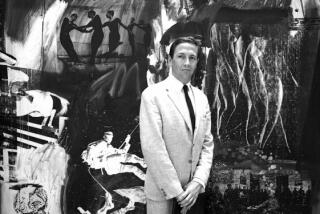‘Welcome in Vienna’--Ironies of Prejudice
- Share via
In the light of the controversy surrounding Kurt Waldheim’s presidency of Austria, the current film “Welcome in Vienna” is a timely reminder that there are probably some skeletons rattling behind Viennese closet doors. Although this drama--directed by Axel Corti and now playing at the Fine Arts--is set at the end of World War II, its depiction of Austrian anti-Semitism, convenient forgetfulness and opportunism is hardly limited to 1945.
“ ‘Welcome in Vienna’ is the third part of ‘Where to and Back,’ ” Corti explained in a recent telephone interview from Austria. “The others deal with his departure from Vienna as a youth, arrival in New York in 1940 and his life as an immigrant in America.” The entire trilogy was presented earlier this month at the Miami Film Festival to critical acclaim.
Bill Cosford, film critic of the Miami Herald, attributed to the trilogy “the weight of Fassbinder’s ‘Berlin Alexanderplatz’ and the accusatory fervor of ‘The Sorrow and the Pity’ and ‘Hearts and Minds.’ ”
Winner of the grand prize at last year’s Chicago Film Festival, “Welcome in Vienna” is an Austrian-German co-production based on the experiences of its screenwriter, Georg Stefan Troller, a Viennese Jew born in 1921.
Like the film’s protagonist, Freddy Wolff (Gabriel Barylli), Troller and his family were forced to flee Austria in 1938 . . . but he returned in 1944 as an American soldier. The slightly surreal feeling of returning to one’s war-ravaged homeland, pockets filled with chewing gum and cigarettes, is one of the emotions the film explores.
When “Welcome in Vienna” was presented at the Cannes Film Festival, Troller recalled that in 1938, “after the Nazis entered Vienna, we knew we had to leave. But it was a wrenching idea: I adored this country that hated me. I didn’t want to emigrate.” But the Troller family did flee, via France and North Africa, to the United States.
Along the way, they learned how isolated refugees could be: After 15 days on foot, they arrived in France and were placed in a camp for “foreign enemies.” According to Troller, “The French didn’t know there was a difference between refugees and Nazis.”
The Viennese exile joined the U.S. Army in 1943 and, along with other German-speaking soldiers (many of them Jewish), was dispatched to Austria in a unit which interrogated prisoners of war.
“Welcome in Vienna” focuses on two uprooted “Americans”--Freddy and Adler (Nicolas Brieger), a Jewish intellectual from Berlin--and their relationship with the Austrians. Freddy falls in love with Claudia (Claudia Messner), a Viennese actress whose father is welcomed by American intelligence agents despite his Nazi allegiances. And when Adler and Freddy are cast in the role of occupiers at war’s end, they must deal with Treschensky (Karlheinz Hackl), a clever, opportunistic Austrian who sides with whomever is in power.
For Corti, a leading Austrian director of cinema, theater, television and radio, “Welcome in Vienna” is partly an attempt to create awareness by confronting Austrian anti-Semitism. “An anti-Semitic attitude has been a long tradition among Austrian Catholics,” he observed in Cannes during an interview last year. “It was imprinted on the political platforms of the Christian People’s parties.”
Troller, also attending the Cannes festival, added that “the Austrians were always more anti-Semitic than the Germans. Hitler didn’t invent anything: He merely elaborated on the ideas of his time. After the Anschluss, 10% of the Austrians signed up with the Nazi Party--in Germany only 7% of the population did so.
“In 1943, at the Moscow Conference, the Austrians managed to obtain the status of a country annexed by Hitler. But in reality, they threw themselves into his arms! What’s happening today shows that they have learned nothing and forgotten nothing.”
Corti was born in Paris in 1933, then grew up in Italy, Switzerland, England, Germany and Austria. The director-actor collaborated with Troller on what is now a trilogy of the writer’s experiences.
Whereas the first two parts of the trilogy--”God Does Not Believe in Us Anymore” and “Santa Fe”--were made for TV, “Welcome in Vienna” was designed for the big screen. Shot in black and white evocative of the period, the cinematography is by Gernot Roll, who also filmed Edgar Reitz’s 15-hour “Heimat.”
Corti, who is not Jewish, suggested that Austrians tend to shrug off the burden of the recent past “because they are afraid of pain. Franz Werfel, an outstanding Austrian novelist, poet and playwright (whose ‘A Woman’s Pale Blue Handwriting’ Corti directed), said ‘Whatever happens in this life is a result of being afraid of pain.”
Whereas Werfel died in the United States in 1945, Troller was one of the lucky Austrians who not only escaped in time, but was able to return in a position of power. He estimated that there were “some thousand immigrants on duty in such investigation teams, many of them Austrian by birth, who--when the war was over--in some cases became members of the country’s military administration, like Freddy.”
The homecoming was often filled with disillusionment, however. Freddy, for example, discovers that his former home is nearly rubble, that love is transient and that success depends on adapting to those in power.
The best exemplar of this accommodation is Treschensky, whom we first meet as a German soldier. “This German soldier is an Austrian,” Corti insisted. “He represents the widespread species of the eternal homo Austriacus . . . whose only motivation is opportunism. Convinced of his charms, he abandons moral strength easily, and considers the ability to suppress problems as primordial in the art of living.”
(If Treschensky occasionally seems reminiscent of the unctuously clever Klaus Maria Brandauer in “Mephisto,” Karlheinz Hackl is indeed a theater actor from the same milieu as Brandauer. And in a small but memorable part, he was the Nazi officer in “Sophie’s Choice” who asked Meryl Streep to choose which of her children should go to the gas chamber.)
Treschensky--and even Adler, after he is refused by the Communist Party--managed to feel at home in the postwar Vienna of cabarets, black-market dealing and sudden prosperity. But Freddy cannot decide whether to remain.
Toller admitted, “I returned to America, was back in Vienna three years later and went to Paris--finally and probably forever. It was simply the best compromise at hand.”
If this trilogy suggests that the United States was the savior for Austrian Jews, America is hardly blameless in “Welcome in Vienna.” With the Cold War approaching, new allegiances were forming and, as Troller put it, “The Americans got along well with the Germans--whether they were Nazis or not. They were obsessed with the desire to fight the Russians. They thought they had fought the wrong war. We, the refugees, were more and more isolated.”
Now that Troller lives in Paris, works for German television and writes scripts that end up as Austrian films, how does he define his nationality? “I am neither Austrian nor German, American nor French,” he replied. “But today, deep down, everyone is from somewhere else. Nobody belongs to one country or one culture, like before. Everyone is searching for a homeland that no longer exists.”
More to Read
Only good movies
Get the Indie Focus newsletter, Mark Olsen's weekly guide to the world of cinema.
You may occasionally receive promotional content from the Los Angeles Times.










